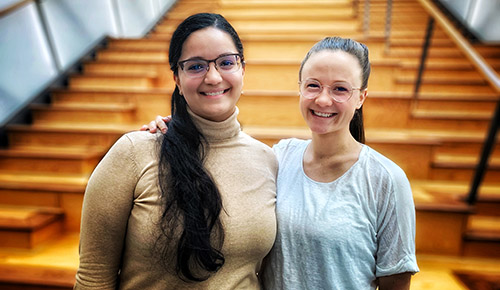
Peter Anto Johnson uses a digital stethoscope on a newborn model. The digital stethoscope is one tool being analyzed as part of a research project.
Tamara Vineberg - 01 October 2019

Peter Anto Johnson uses a digital stethoscope on a newborn model. The digital stethoscope is one tool being analyzed as part of a research project.
Peter Anto Johnson understands that a few seconds can mean the difference between life and death. When he was an infant, he was diagnosed with intussusception-a condition that twists and clogs the intestines. His family was living in rural India where access to healthcare was limited.
"It was a miracle that I was able to survive because, as soon as my family got to the hospital, I had emergency surgery and wouldn't have survived if we were delayed by even a few seconds. This really influenced me to pursue pediatrics and newborn medicine," says Johnson, now a graduate student in the Department of Pediatrics.
Johnson joins fellow learners Emily Zehnder and Simran Ghoman in the Centre for Studies of Asphyxia and Resuscitation (CSAR) where the three have separate research projects using technology to make a difference in newborn care. All three are supervised by Georg Schmӧlzer, associate professor in the Division of Neonatal-Perinatal Care.
A phone app and digital stethoscope could improve survival
Seconds matter in neonatal resuscitation. That's why Johnson is drawn to examining the use of a phone app called NeoTapLifeSupport (NeoTapLS). The app can be paired with a stethoscope for heart rate assessment. Healthcare providers tap the app as they hear the heartbeat, which provides the timing interval for the app's algorithm to calculate heart rate. "During lab testing, we determined using the app provides a faster heart rate assessment time compared to currently recommended methods using only the stethoscope," he says.
Johnson is also examining the use of a digital stethoscope, which can detect the heart rate or heartbeat much more accurately than the standard counterparts. "This is the first time that we are looking at this technology for heart rate assessments in newborn infants. We're comparing the accuracy of a digital stethoscope versus a normal stethoscope, which we'll soon validate by starting a clinical trial at the Royal Alexandra Hospital," he explains.
"With new innovations coming out, the heart of research has really shifted more towards gaining a fuller view of these game-changing technologies," adds Johnson.
Eye tracking glasses used for two studies
Zehnder and Ghoman are using eye tracking glasses in separate research projects. This special technology is worn by clinicians to record eye movements during procedures or other activities.

Learners Emily Zehnder and Simran Ghoman